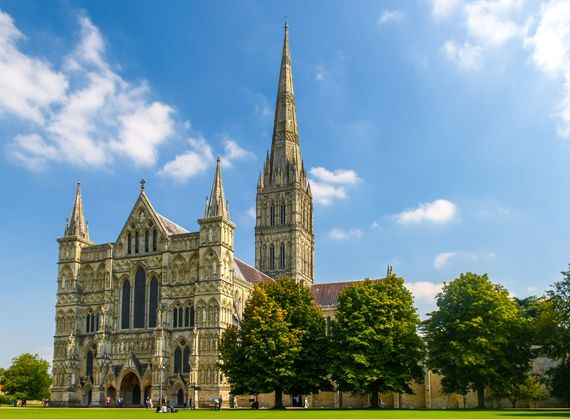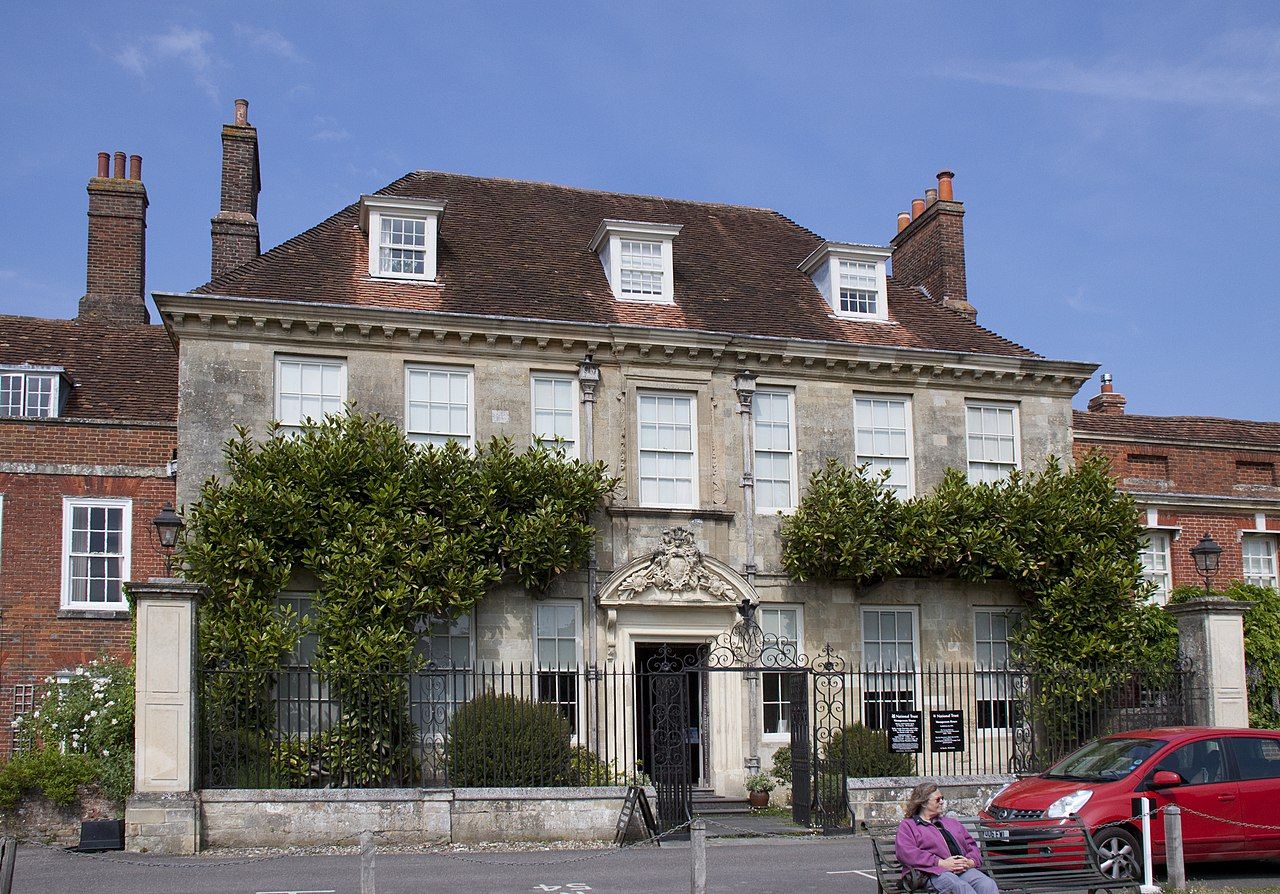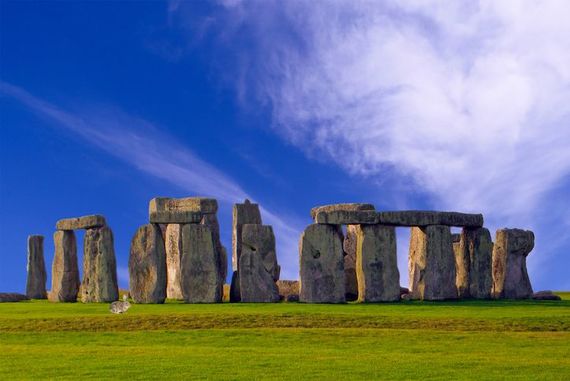
Stonehenge, in Wiltshire.
Wiltshire is a home to some of Britain's best heritage attractions, including Salisbury Cathedral, the Magna Carta, and Stonehenge.
Old Sarum

Walls around Old Sarum.
Old Sarum in Salisbury is the site of a former castle built by William the Conqueror, which passed to the Bishop of Sarum in 1130, then back to the crown upon his death nine years later. Henry II made some improvements to the castle, and from 1173 until 1189 Henry’s queen, Eleanor of Aquitaine, stayed there under house arrest for having encouraged her sons to rebel against their father, the King.
The castle remained an administrative centre until King Henry VIII gave it to Thomas Compton, allowing him to dismantle the fortress and use the bricks as building materials. He left it pretty much as we see it today.
An early version of Salisbury Cathedral was built beside the castle at Old Sarum in the 11th century. It served as a monastery for a while, but was very exposed. The monks suffered from rheumatism from the wind and rain, and the quality of the drinking water was a big problem.
Richard Poore, Bishop of Salisbury, complained about the conditions until eventually permission was granted to move the Cathedral to its current position in the city. Today, you can see the foundation stones of the early cathedral on the site of Old Sarum.
Visitors can walk around the outer edge of the hill fort, on a raised plateau that marks the edge of a former Iron Age community settlement. People lived here long before William the Conqueror built his castle. Both the castle, and the hill fort are surrounded by huge ditches, like an empty moat, which would have been dug out by hand, making it difficult for enemies to approach.
The views across Salisbury City from Old Sarum are excellent. You can see the Cathedral and watch numerous small aeroplanes take off from the nearby air field. www.english-heritage.org.uk
Salisbury Cathedral and the Magna Carta

Salisbury Cathedral.
The impressive architecture of Salisbury Cathedral is breathtaking, and sometimes it's complemented by exhibitions of modern art. There was a collection of stunning tapestries depicting scenes from the book of Revelation when we visited. We walked through the glorious cloisters to the Magna Carta exhibition - one of the copies of the manuscript is housed here.
The Magna Carta is about 3550 words written on a single sheet of fine animal skin. The exhibition offers a translation of the text and a commentary about the monarch, King John, at the time.
The Magna Carta enabled the English to get some of the freedoms they still enjoy today. For example, people cannot be held indefinitely without trial, and the monarch and Parliament both have to work within the law - they are not above it. Some parts of the Magna Carta are very dated, and others are controversial. Only four are held in law today, but none-the-less, the document had a big impact on the power of the monarch in England. www.salisburycathedral.org.uk
Mompesson House

Mompesson House.
Mompesson House is a National Trust property in Salisbury City Centre. The house was given to the National Trust in 1975 by Denis Martineau, the architect of the house. It was redecorated and filled with beautiful furniture before it opened to the public in 1977.
It's a beautiful property with fabulous plasterwork decoration on many walls and ceilings. The Trust painted over a lot of the colourful decorative schemes when they inherited it. This might seem a shame, but it's tastefully done, and there are some fascinating artefacts inside.
Items on display include a tea-mixing caddy (to blend your own flavours), smelling salts to make you feel better, an extensive collection of ornamental wine glasses, delicate porcelain, a small but perfectly formed library, beautiful bedrooms, and a charming cafe. It's an interesting and quirky house, full of treasures. www.nationaltrust.org.uk
Stonehenge

Stonehenge.
The Stonehenge tour begins with a fabulous immersive 360° CGI experience showing Stonehenge changing through the ages. It starts with the landscape before the henge was built, and takes you through centuries of change, showing Stonehenge in its heyday, and then falling to ruin.
There's also a museum about life in Stone Age Britain and the lifestyles of the people who lived near the henge. Neolithic houses are recreated outside the visitor center and three are open, so you can go inside.
It takes about half an hour to walk from the visitor center to Stonehenge, past ancient burial mounds and earthworks. You can take the shuttle bus if you prefer.
Stonehenge was turned into a chargeable visitor attraction in 1901, partly to prevent damage to the stones, which were being chipped away by Victorian visitors who were keen to take home a 'souvenir'.
The decision to fence the stone circle and charge a fee wasn't popular with everyone, but plenty of people still visited. In the 1960s and '70s visitor numbers increased so much that the grass around the stones died and gravel laid in its place damaged the monument. So from 1978, Stonehenge was roped off and visitors were only allowed to walk around its circumference. This was an unpopular move, but a necessary price to preserve the stones for future generations.
Today, the visitor center, museum, recreated village, cafe and careful landscaping, all combine to enhance the visitor experience, securing it's position as one of Britain's most popular attractions. www.english-heritage.org.uk
Avebury Henge
At nearby Avebury you can visit Avebury Manor, Avebury Henge - the biggest stone circle in Europe - and two museums.
The Manor was refurbished by Penelope Keith and a design team in a television program, The Manor Reborn, shown on BBC1 in 2011. Today, the interiors still look fresh and new, and are absolutely stunning.
Unusually for historic properties, they're keen to get everyone inside using things - you can play billiards in the Billiard Room, exercise on the weird exercise seat in the Dining Room, and lounge on the 1930s chairs in front of the fire in the 1930s Sitting Room.
Each room is decorated to represent a different time in history and a different owner. The Chinese wallpaper in the Dining Room is particularly stunning, but my favourite room is the red and gold bedroom, with a four poster bed, drapes, and dramatic wall panelling. Outside, the gardens are pretty, with beautiful topiary and floral borders. Sometimes they have artwork and sculptures on display.
It's a very short walk to Avebury Henge, a massive stone circle, and there are some unusual sights here, including druids conducting ceremonial rites. It's an interesting place to spend some time and it's home to the world's only pub inside a Stone Circle, The Red Lion. You can walk from Avebury Henge down the Avenue to the Sanctuary if you have time to explore more of the ancient landscape. www.nationaltrust.org.uk
Longleat
Longleat Safari Park near Warminster is a huge attraction with a drive-through safari, walk around animal enclosures, fairground rides and a dinosaur trail. There's an Elizabethan mansion too, which is usually open to visitors, but has been closed in recent times due to the pandemic.
On the safari drive you might see roaring tigers, lions lazing in the road, monkeys climbing on the cars, deer peering into the windows, and giraffes towering over the traffic.
There's a boat safari with hippos. Sea lions splash in the water, begging for food. You'd think they hadn't been fed for a year, but they actually get fed approximately every ten minutes by people on the boats! Sea lion food is £1 a cup.
If you're lucky enough to visit when Longleat House is open, the interiors are spectacular. Today Lord and Lady Bath live in the West Wing. Look out for the Lord Bath's eccentric artwork and murals - they're quite a conversation opener!
Other attractions at Longleat include gardens, life-size dinosaurs, a miniature railway, and small animal enclosures for a variety of creatures including marmosets, prairie dogs and meerkats.
The parrot show is well worth seeing. We watched macaw parrots perform on little bicycles, scooters, and even their own cars. They're quite clever and can also raise a flag on a mast, and fill a parrot sized shopping basket.
We went into the lorikeet enclosure where, as always, the parrots took a liking to my husband. He had five on them standing on his head, shoulders and arms, within seconds of stepping inside! Finally, we watched an oriental acrobatic show put on by a visiting theatre company from Asia.
If you go in the wintertime, the Winter Illuminations are dazzling, with thousands of lights and a themed trail around the grounds.
A day at Longleat is a very full day, and there are many more animals to see, as well as a house of mirrors, a bat cave, butterfly house, farm, and kids' activities. There is no danger of getting bored. www.longleat.co.uk
Prior Park
Prior Park is a beautiful landscaped garden just outside Bath. It was originally created by Ralph Allen, who made his fortune at the age of 19, when he became the postmaster in Bath and then took over the whole postal system outside of London. He later made money quarrying stone and created Prior Park to show off his wealth. Today the gardens belong to the National Trust.
We followed a route through the gardens, passing a grotto, a Gothic Temple and mansion, before reaching a viewpoint overlooking the city of Bath. From here, you can see the Royal Crescent, Camden Crescent, church spires and other landmarks. An iconic bridge, decorated with 19th-century graffiti, is a great centerpiece over a lake. www.nationaltrust.org.uk
Devizes
The historic town of Devizes is home to Wadworth Brewery, which has been brewing beer in the town since 1875 and is still going strong. They usually offer visitor tours, but due to the pandemic they currently have a different approach: "beer sampling, beer chat and a brewing talk, as well as ale trails around Wadworth pubs in the local area". Not a bad alternative!
The town offers a diverse mix of shopping and cultural experiences. It's home to Wiltshire Museum, where you can explore 500,000 years of history with a Bronze Age hut, fascinating galleries, and lots of interactive fun for the kids.
The town also has a full calendar of events throughout the year. There's Devizes Street Festival every year in May, Devizes Arts Festival in June, a Carnival Parade in July, Picnic in the Park, or the Colour Rush in August. There's also a Winter Festival and an Ale Festival!
The Corn Exchange, built in 1856, is an impressive building, with tall pillars, decorative stonework and a statue of Ceres, Goddess of Grain, on the roof. The town has a 14th century coaching inn, where you can go for a relaxing brew.
The Market Cross monument in the Market Square bears the story of Ruth Pierce, who in 1753 was accused of theft. She asked God to strike her dead if she was lying. So he did. The stolen money was found in her hand.
A leisurely stroll along the canal is worthwhile. You might see blue-green dragonflies and water birds. Boats pass through the quiet glades; it's very relaxing.
Old Wardour Castle
Old Wardour Castle was built in the late 14th century, ruined during the Civil War, and used as an ornamental garden feature from the 18th century onwards. A new castle was built nearby on the estate, and a summerhouse was built beside the old ruins to accommodate food and wine laid on for guests at garden parties.
The romantic ruin became the centerpiece at many summer social occasions. Today visitors explore the ruined rooms across all four floors. Learn about the history, imagine how the rooms might have been used, and find out about the people who lived and worked at Old Waldour Castle. www.english-heritage.org.uk
Wiltshire is a gem of historic sites and fascinating places to visit. To find out more visit: www.visitwiltshire.co.uk
* Originally published in 2022.





Comments